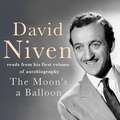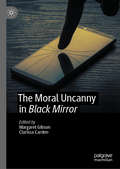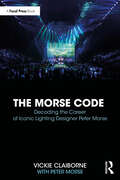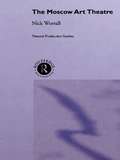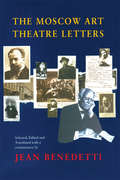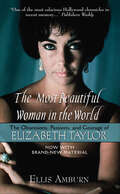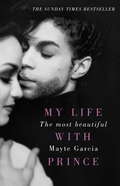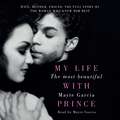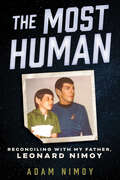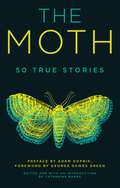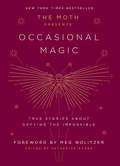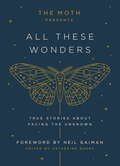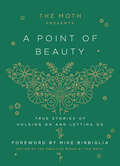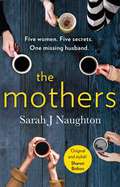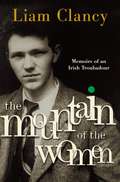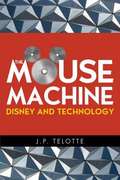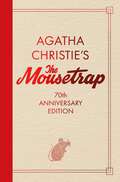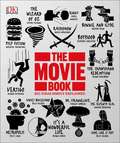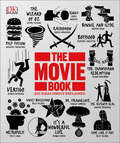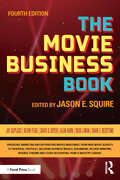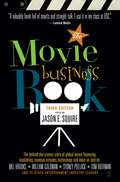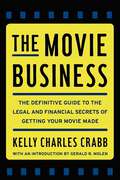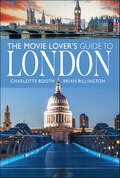- Table View
- List View
The Moon's a Balloon
by David NivenDavid Niven is remembered as one of Britain's best-loved actors. The archetypal English gentleman, he starred in over ninety films. He is equally remembered as the author of this classic autobiography.In his first volume, he remembers his childhood and school days, his time at Sandhurst and his early army service. He recalls America during the prohibition era and days in Hollywood before the Second World War. Of the war itself, he tells of family life back in Britain and his time on the front line in France and Germany.THE MOON'S A BALLOON is a wonderful record of a truly remarkable and warm-hearted man, told in his inimitable style.(P)2005 Headline Digital
The Moral Uncanny in Black Mirror
by Margaret Gibson Clarissa CardenThis erudite volume examines the moral universe of the hit Netflix show Black Mirror. It brings together scholars in media studies, cultural studies, anthropology, literature, philosophy, psychology, theatre and game studies to analyse the significance and reverberations of Charlie Brooker’s dystopian universe with our present-day technologically mediated life world. Brooker’s ground-breaking Black Mirror anthology generates often disturbing and sometimes amusing future imaginaries of the dark side of ubiquitous screen life, as it unleashes the power of the uncanny. This book takes the psychoanalytic idea of the uncanny into a moral framework befitting Black Mirror’s dystopian visions. The volume suggests that the Black Mirror anthology doesn’t just make the viewer feel, on the surface, a strange recognition of closeness to some of its dystopian scenarios, but also makes us realise how very fragile, wavering, fractured, and uncertain is the human moral compass.
The Morse Code: Decoding the Career of Iconic Lighting Designer Peter Morse
by Vickie Claiborne Peter MorseThe Morse Code: Decoding the Career of Iconic Lighting Designer Peter Morse explores key developments and evolving techniques, processes, and technology within contemporary theatrical lighting design through the career and impact of US lighting designer Peter Morse.Peter Morse’s career as a lighting designer spans over 50 years. He has worked with most of entertainment’s biggest artists, including Michael Jackson, Barbra Streisand, Madonna, Prince, and many more. This book documents his firsthand perspective of how the entertainment industry has changed, and it features his unique perspective on how the evolution of the lighting industry resulted in an evolution of his design and practice. More than a simple biography, this book explores the history of contemporary lighting design through Peter’s eyes and experience, tracing the evolution of technology and trends, and how one designer’s creativity impacted an industry. Each chapter explores the work of a decade and is illustrated with personal interest stories from his collaborations with iconic artists and production photography.The Morse Code is a valuable resource for new and experienced lighting designers, students of lighting design, and those interested in the history of technical theatre.
The Moscow Art Theatre (Theatre Production Studies)
by Nick WorrallUnprecedented in its comprehensiveness, The Moscow Art Theatre fills a large gap in our knowledge of Stanislavsky and his theatre. Worrall focuses in particular detail on four of The Moscow Art Theatre's best-known productions: * Tolstoy's Tsar Fedor Ioannovich * Gorky's The Lower Depths * Chekov's The Cherry Orchard * Turgenev's A Month in the Country
The Moscow Art Theatre Letters
by Jean BenedettiMoscow Art Theatre Letters tells the real story of the Moscow Art Theatre, from its origin at the turn of the century through its first forty years. Jean Benedetti presents the historical record first-hand in this collection of the letters of the main protagonists. Many are available in English for the first time--all will come as a revelation to Western readers.
The Most Beautiful Woman in the World: The Obsessions, Passions, and Courage of Elizabeth Taylor
by Ellis AmburnEllis Amburn's magnificent biography of the Academy Award®-winning actress and legendary beauty captures the unparalleled Elizabeth in all her tragedy and splendor—her tumultuous loves, her doomed affections, her shocking excesses, her courage, and her inimitable style. Filled with stunning revelations about the men in her life—Burton, Clift, Hilton, Dean, Fisher—it is a glorious celebration of the turbulent life of a brilliant star that none in Hollywood or heaven could ever outshine.
The Most Beautiful: My Life With Prince
by Mayte GarciaIn The Most Beautiful, a title inspired by the hit song Prince wrote about their legendary love story, Mayte Garcia for the first time shares the deeply personal story of their relationship and offers a singular perspective on the music icon and their world together: from their unconventional meeting backstage at a concert (and the long-distance romance that followed), to their fairy-tale wedding (and their groundbreaking artistic partnership), to the devastating losses that ultimately dissolved their romantic relationship for good. Throughout it all, they shared a bond more intimate than any other in Prince's life. No one else can tell this story or can provide a deeper, more nuanced portrait of Prince--both the famously private man and the pioneering, beloved artist--than Mayte, his partner during some of the most pivotal personal and professional years of his career. The Most Beautiful is a book that will be returned to for decades, as Prince's music lives on with generations to come.
The Most Beautiful: My Life With Prince
by Mayte GarciaIn The Most Beautiful, a title inspired by the hit song Prince wrote about their legendary love story, Mayte Garcia for the first time shares the deeply personal story of their relationship and offers a singular perspective on the music icon and their world together: from their unconventional meeting backstage at a concert (and the long-distance romance that followed), to their fairy-tale wedding (and their groundbreaking artistic partnership), to the devastating losses that ultimately dissolved their romantic relationship for good. Throughout it all, they shared a bond more intimate than any other in Prince's life. No one else can tell this story or can provide a deeper, more nuanced portrait of Prince--both the famously private man and the pioneering, beloved artist--than Mayte, his partner during some of the most pivotal personal and professional years of his career. The Most Beautiful is a book that will be returned to for decades, as Prince's music lives on with generations to come.Written and read by Mayte Garcia(p) 2017 Hachette Audio
The Most Human: Reconciling with My Father, Leonard Nimoy
by Adam Nimoy"Adam Nimoy has written about the challenges growing up with his famous father and about their estrangement later in life. The fact that Leonard and Adam found a way to rebuild their relationship should resonate with anyone who struggles with difficult family dynamics."—George Takei"Engaging and immensely relatable, while at the same time offering deeply profound insights into Adam Nimoy's personal relationships, particularly with his famous father." —Eugene Roddenberry Jr., CEO Roddenberry Entertainment While the tabloids and fan publications portrayed the Nimoys as a "close family," to his son Adam, Leonard Nimoy was a total stranger. The actor was as inscrutable as the iconic half-Vulcan science officer he portrayed on Star Trek, even to those close to him. Now, his son's poignant memoir explores their complicated relationship and how it informed his views on marriage, parenting, and later, sobriety. Despite their differences, both men ventured down parallel paths: marriages leading to divorce, battling addiction, and finding recovery. Most notably, both men struggled to take the ninth step in their AA journey: to make amends with each other.Discover how the son of Spock learned to navigate this tumultuous relationship—from Shabbat dinners to basement AA meetings—and how he was finally able to reconcile with his father—and with himself.
The Moth
by George Dawes Green Adam Gopnik Catherine Burns The MothThe first collection from celebrated storytelling phenomenon The Moth presents fifty spellbinding, soul-bearing stories selected from their extensive archive. With tales from writer Malcolm Gladwell's wedding toast gone horribly awry; legendary rapper Darryl "DMC" McDaniels' obsession with a Sarah McLachlan song; poker champion Annie Duke's two million-dollar hand; and A. E. Hotchner's death-defying stint in a bullring . . . with his friend Ernest Hemingway. Read about the panic of former Clinton Press Secretary Joe Lockhart when he misses Air Force One after a hard night of drinking in Moscow, and Dr. George Lombardi's fight to save Mother Teresa's life. Inspired by friends telling stories on a porch, The Moth was born in small-town Georgia, garnered a cult following in New York City, and then rose to national acclaim with the wildly popular podcast and Peabody Award-winning weekly public radio show The Moth Radio Hour. A beloved read for Moth enthusiasts and all who savor well-told, hilarious, and heartbreaking stories.
The Moth Presents: True Stories About Defying the Impossible (The Moth Presents #2)
by Meg Wolitzer Catherine BurnsNEW YORK TIMES BESTSELLER • From storytelling phenomenon and hit podcast The Moth—and featuring contributions from Meg Wolitzer, Adam Gopnik, Krista Tippett, Andrew Solomon, Rosanne Cash, Ophira Eisenberg, Wang Ping, and more—a new collection of unforgettable true stories about finding the strength to face the impossible, drawn from the very best ever told on its stagesCarefully selected by the creative minds at storytelling phenomenon The Moth, and adapted to the page to preserve the raw energy of stories told live, onstage and without notes, Occasional Magic features voices familiar and new. Inside, storytellers from around the world share times when, in the face of seemingly impossible situations, they found moments of beauty, wonder, and clarity that shed light on their lives and helped them find a path forward. From a fifteen-year-old saving a life in Chicago to a mother of triplets trekking to the North Pole to a ninety-year-old Russian man recalling his standoff with the KGB, these storytellers attest to the variety and richness of the human experience, and the shared threads that connect us all. With honesty and humor, they stare down their fear, embrace uncertainty, and encourage us all to be more authentic, vulnerable, and alive.
The Moth Presents: True Stories About Facing the Unknown (The Moth Presents #1)
by Neil Gaiman Catherine Burns&“Wonderful." —Michiko Kakutani, New York TimesCelebrating the 20th anniversary of storytelling phenomenon The Moth, 45 unforgettable true stories about risk, courage, and facing the unknown, drawn from the best ever told on their stagesCarefully selected by the creative minds at The Moth, and adapted to the page to preserve the raw energy of live storytelling, All These Wonders features voices both familiar and new. Alongside Meg Wolitzer, John Turturro, and Tig Notaro, readers will encounter: an astronomer gazing at the surface of Pluto for the first time, an Afghan refugee learning how much her father sacrificed to save their family, a hip-hop star coming to terms with being a &“one-hit wonder,&” a young female spy risking everything as part of Churchill&’s &“secret army&” during World War II, and more. High-school student and neuroscientist alike, the storytellers share their ventures into uncharted territory—and how their lives were changed indelibly by what they discovered there. With passion, and humor, they encourage us all to be more open, vulnerable, and alive.
The Moth Presents: True Stories of Holding On and Letting Go (The Moth Presents)
by Mike Birbiglia The MothAn inspiring and entertaining collection of unforgettable true stories about finding unexpected beauty in life&’s transitions—from Lin-Manuel Miranda, Elizabeth Gilbert, Quiara Alegría Hudes, and many more. &“The Moth taught me how to be vulnerable, how to take my time, and how to listen to someone else&’s story and share in their moments of triumph, laughter, or, yes, sometimes embarrassment with an open heart.&”—Mike Birbiglia, from the Foreword An international rescue mission for Paddington Bear. A family matriarch running numbers in Detroit. An epic Lucha Libre showdown in Mexico City. A beach vacation spent looking for the Kennedys. Storytellers from around the world share times they found real beauty in the moments when their lives changed forever—for better or for worse. Carefully selected by the creative minds at The Moth and adapted to the page to preserve the raw energy of stories told live, on stage, and without notes, A Point of Beauty features voices familiar and new. This collection offers a shared message: If we look closely enough, we can find power in strengthening frayed bonds but also in having the courage to walk away from things that no longer feed our spirit. Through these storytellers&’ passion and their hope, they teach us all about what&’s worth holding on to: our relationships with those we love the most, our understanding of ourselves, and—of course—gathering together to tell and listen to our stories.
The Mothers: Five women. Five secrets. One missing husband.
by Sarah J NaughtonFROM THE NUMBER ONE BESTSELLING AUTHOR'Dazzlingly inventive'Sunday Times, Crime Book of the Month'A meticulously plotted exploration of friendship, foe-ship and the lies that bind, which builds to a gripping and powerful conclusion'Cara Hunter********** FIVE WOMEN.They meet at their NCT Group. The only thing they have in common is they're all pregnant. FIVE SECRETS.Three years later, they are all good friends. Aren't they? ONE MISSING HUSBAND.Now the police have come knocking. Someone knows something. THE TROUBLE WITH SECRETS IS THAT SOMEONE ALWAYS TELLS...********** 'The perfect dose of thrills and suspense, this will keep you engrossed to the very end' Heat'Original and stylish... will keep you guessing to the last page'Sharon BoltonFor fans of Big Little Lies, The Rumour and I Invited Her In, this is first class psychological suspense from the critically acclaimed Sarah J Naughton.
The Mothers: Five women. Five secrets. One missing husband.
by Sarah J NaughtonFROM THE NUMBER ONE BESTSELLING AUTHOR'Dazzlingly inventive'Sunday Times, Crime Book of the Month'A meticulously plotted exploration of friendship, foe-ship and the lies that bind, which builds to a gripping and powerful conclusion'Cara Hunter********** FIVE WOMEN.They meet at their NCT Group. The only thing they have in common is they're all pregnant. FIVE SECRETS.Three years later, they are all good friends. Aren't they? ONE MISSING HUSBAND.Now the police have come knocking. Someone knows something. THE TROUBLE WITH SECRETS IS THAT SOMEONE ALWAYS TELLS...********** 'The perfect dose of thrills and suspense, this will keep you engrossed to the very end' Heat'Original and stylish... will keep you guessing to the last page'Sharon BoltonFor fans of Big Little Lies, The Rumour and I Invited Her In, this is first class psychological suspense from the critically acclaimed Sarah J Naughton.
The Mountain of the Women: Memoirs of an Irish Troubadour
by Liam ClancyIn an irresistible tale of a life lived fully, if not always wisely, Liam Clancy, of the legendary Irish group the Clancy Brothers, describes his eventful journey from a small town in Ireland in the 1930s into the heart of the New York music scene in the 1950s and '60s. Following in the grand tradition of such Irish memoirs as Angela's Ashes and Are You Somebody?, Liam Clancy relates his life's story in a raucously funny and star-studded account of moving from provincial Ireland to the bars and clubs of New York City, to the cusp of fame as a member of Tommy Makem and the Clancy Brothers. Born in 1935, the eleventh out of as many children, young Liam was a naive and innocent lad of the Old Country. His memories of childhood include bounding over hills, streams, and the occasional mountain, getting lost, and eventually found, and making mischief in the way of a typical Irish boy. As an aimless nineteen-year-old, Clancy met a strange and wonderfully energetic lover of music, Ms. Diane Guggenheim, an American heiress. She and a colleague from America had set out to record regional Irish folk music, and their undertaking led them to Carrick-on-Suir in the shadow of Slievenamon, "The Mountain of the Women," where Mammie Clancy had been known to carry a tune or two in her kitchen. Guggenheim fell for young Liam and swept him along on her travels through the British Isles, the American Appalachians, and finally Greenwich Village, the undisputed Mecca for aspiring artists of every ilk in the late 1950s. Clancy was in New York to become an actor. But on the side, he played and sang with his brothers, Paddy and Tom, and fellow countryman Tommy Makem, in pubs like the legendary White Horse Tavern. In the heady atmosphere of the Village, Clancy's life was a party filled with music, sex, and McSorley's. His friendships with then-unknown artists such as Bob Dylan, Maya Angelou, Robert Redford, Lenny Bruce, Pete Seeger and Barbra Streisand form the backdrop of the charming adventures of a small-town boy making it big in the biggest of cities. In music circles, the Clancy Brothers and Tommy Makem are known as the Beatles of Irish music. The band's music continues to play on jukeboxes in pubs and bars, in living rooms of folk music fans, and in Irish American homes throughout the country. Liam Clancy's lively memoir captures their wild adventures on the road to fame and fortune, and brings to life a man who never lets himself off the hook for his sins, and happily views his success as a blessing.
The Mouse Machine: Disney and Technology
by J P. TelotteThroughout Disney's phenomenally successful run in the entertainment industry, the company has negotiated the use of cutting-edge film and media technologies that, J. P. Telotte argues, have proven fundamental to the company's identity. Disney's technological developments include the use of stereophonic surround sound for Fantasia, experimentation with wide-screen technology, inaugural adoption of three-strip Technicolor film, and early efforts at fostering depth in the animated image. Telotte also chronicles Disney's partnership with television, development of the theme park, and depiction of technology in science fiction narratives. An in-depth discussion of Disney's shift into digital filmmaking with its Pixar partnership and an emphasis on digital special effects in live-action films, such as the Pirates of the Caribbean series, also highlight the studio's historical investment in technology. By exploring the technological context for Disney creations throughout its history, The Mouse Machine illuminates Disney's extraordinary growth into one of the largest and most influential media and entertainment companies in the world. Hardback is unjacketed.
The Mousetrap: 70th Anniversary Edition
by Agatha Christie'Even more thrilling than the plot is the atmosphere of shuddering suspense . . . No one brews it better than Agatha Christie' Daily ExpressFor 70 years, Agatha Christie's The Mousetrap has kept millions of people, from every corner of the globe, on the edge of their seats, and it continues to be a sell-out hit of London theatre. This brand new edition of the world's longest-running play will contain a new introduction by Sophie Hannah, bestselling author of the authorised Agatha Christie Poirot continuation novels, as well as the official play script and a host of exclusive material from the show's archives. As news spreads of a murder in London, a group of seven strangers find themselves in a remote countryside guesthouse. When a police sergeant arrives, the guests discover - to their horror - that a killer is in their midst. One by one, the suspicious characters reveal their sordid pasts. Which one is the murderer? Who will be their next victim? And can you solve this world-famous mystery for yourself?This beautiful 70th anniversary edition will contain an introduction by Sophie Hannah, the official playscript, an exclusive interview with producer Adam Spiegel, a treasure trove of letters, speeches, photographs, and other fascinating insights into the making of this iconic play.
The Mousetrap: 70th Anniversary Edition
by Agatha Christie'Even more thrilling than the plot is the atmosphere of shuddering suspense . . . No one brews it better than Agatha Christie' Daily ExpressFor 70 years, Agatha Christie's The Mousetrap has kept millions of people, from every corner of the globe, on the edge of their seats, and it continues to be a sell-out hit of London theatre. This brand new edition of the world's longest-running play will contain a new introduction by Sophie Hannah, bestselling author of the authorised Agatha Christie Poirot continuation novels, as well as the official play script and a host of exclusive material from the show's archives. As news spreads of a murder in London, a group of seven strangers find themselves in a remote countryside guesthouse. When a police sergeant arrives, the guests discover - to their horror - that a killer is in their midst. One by one, the suspicious characters reveal their sordid pasts. Which one is the murderer? Who will be their next victim? And can you solve this world-famous mystery for yourself?This beautiful 70th anniversary edition will contain an introduction by Sophie Hannah, the official playscript, an exclusive interview with producer Adam Spiegel, a treasure trove of letters, speeches, photographs, and other fascinating insights into the making of this iconic play.
The Movie Book: Big Ideas Simply Explained (Big Ideas Simply Explained)
by DkDoes Chinatown subvert the film noir genre? What is the effect of Pulp Fiction’s episodic plot? How do multiple points of view undermine notions of reality in Rashomon? The Movie Book answers these questions and more as it chronicles the greatest movies ever to grace the silver screen. From the golden age of black-and-white films to international art-house and 21st-century sci-fi, this book uncovers the key themes and big ideas behind more than 100 of the world's most celebrated cinematic gems. Whether you are a fan of comedies, romance, musicals, action movies, or thrillers, The Movie Book is essential for anyone with a passion for cinema.
The Movie Book: Big Ideas Simply Explained (DK Big Ideas)
by DKLearn about the visual and performing arts in The Movie Book.Part of the fascinating Big Ideas series, this book tackles tricky topics and themes in a simple and easy to follow format. Learn about Movies in this overview guide to the subject, great for beginners looking to learn and experts wishing to refresh their knowledge alike! The Movie Book brings a fresh and vibrant take on the topic through eye-catching graphics and diagrams to immerse yourself in. This captivating book will broaden your understanding of Movies, with:- More than 100 of the best movies ever made worldwide- Packed with facts, charts, timelines and graphs to help explain core concepts- A visual approach to big subjects with striking illustrations and graphics throughout- Easy to follow text makes topics accessible for people at any level of understandingThe Movie Book is the perfect introduction to the rich history of cinema like never before - from the golden age of black-and-white films to international art-house and 21st-century sci-fi, aimed at adults with an interest in the subject and students wanting to gain more of an overview. Here you&’ll discover more than 100 of the best movies ever made, uncovering the key themes and big ideas behind the world's most celebrated cinematic gems.Your Movie Questions, Simply ExplainedThis book brings cinema to life with iconic quotes and film stills, posters, biographies of directors, actors, and actresses, along with narrative timelines and infographics exploring key themes. If you thought it was difficult to learn about the best cinematic masterpieces, The Movie Book presents key information in an easy to follow layout. Learn everything about your favorite movies, as well as celebrated classics and the films to watch before you die, through iconic quotes and stills, posters, biographies, memorabilia and narrative timelines, through fantastic mind maps and step-by-step summaries. The Big Ideas SeriesWith millions of copies sold worldwide, The Movie Book is part of the award-winning Big Ideas series from DK. The series uses striking graphics along with engaging writing, making big topics easy to understand.
The Movie Business Book
by Jason E. SquireTapping experts in an industry experiencing major disruptions, The Movie Business Book is the authoritative, comprehensive sourcebook, covering online micro-budget movies to theatrical tentpoles. This book pulls back the veil of secrecy on producing, marketing, and distributing films, including business models, dealmaking, release windows, revenue streams, studio accounting, DIY online self-distribution and more. First-hand insider accounts serve as primary references involving negotiations, management decisions, workflow, intuition and instinct. The Movie Business Book is an essential guide for those launching or advancing careers in the global media marketplace.
The Movie Business Book, Third Edition
by Jason E. SquireDrawing from a variety of experts in an industry that has seen major technological advances since the second edition, The Movie Business Book, Third Edition, offers the most comprehensive, authoritative overview of this fascinating, global business. A must-read for industry newcomers, film students and movie buffs, this new edition features key movers and shakers, such as Tom Rothman, chairman of Fox Filmed Entertainment; Michael Grillo, head of Feature Film Production at DreamWorks SKG; Sydney Pollack; Mel Brooks; and many others. A definitive sourcebook, it covers nuts-and-bolts details about financing, revenue streams, marketing, DVDs, globalization, the Internet and new technologies. All of this -- and more -- is detailed in this new edition of the classic Movie Business Book.
The Movie Business: The Definitive Guide to the Legal and Financial Secrets of Getting Your Movie Made
by Kelly CrabbMaking a movie may be part art and part science, but it's 100 percent business. In this comprehensive and accessible guide, Kelly Charles Crabb shares the information necessary to understand the legal and financial challenges involved in getting a film from story to the silver screen and beyond. Drawing on over twenty years of experience in the entertainment industry, as both lawyer and producer, Crabb reveals his insider's knowledge on: Understanding copyright and intellectual property law Obtaining financial backing Selecting and hiring the key players Overseeing the filming Locking in the theatrical, home video, and TV distribution Understanding merchandise licensing and everything else you need to know to make a serious run at producing and exploiting a movie. Offering hands-on illustrations from actual movie contracts to show how the basic deals for each of the many stages are assembled, the author explains in plain and simple terms what the contracts contain and why. It gives the big picture and the finer points of movie making -- from concept to raking in the last dollar after the film is completed. While it may not transform you into a lawyer or an industry accountant -- and that's not what you want anyway -- it will take you through all the business and legal principles you need to know to be a successful and knowledgeable professional producer.
The Movie Lover’s Guide to London (City Guides)
by Charlotte Booth Brian BillingtonLondon is a magical place which has intrigued people for more than 2,000 years, and never is this more apparent than in the past 130 years following the invention of the moving image. London has been a draw for filmmakers for decades, and this book guides you through the locations, in the shadow of some of your favorite movies. Take a tour by movie, go on a movie pub crawl, a leisurely stroll through cemeteries with connections to the movies or create your own tour by postcode. This book will allow you to visit new parts of London but with the familiarity of a well-loved film. With more than 500 movie locations from 91 films covering more than six decades of movie making and more than 100 images, this book will have something for everyone and will show you London in a new, sparkling, glamourous light.
